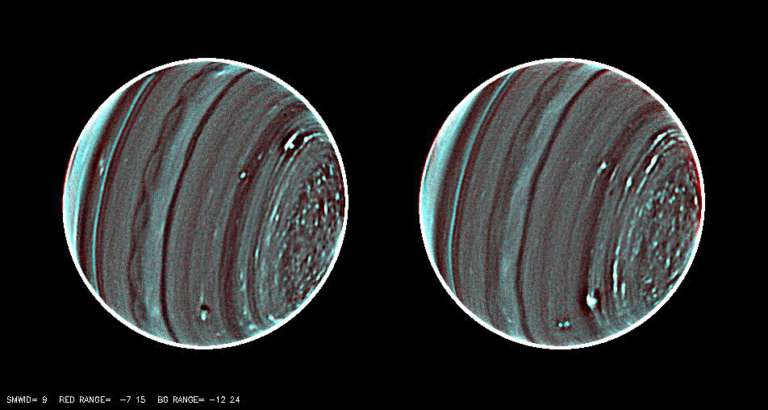Bruce Murray Space Image Library
High signal-to-noise images of Uranus from Keck II

The most detailed images of Uranus ever obtained from Earth. These two images of Uranus are composites of 117 images from 25 July 2012 (left) and 118 images from 26 July 2012 (right), all obtained with the near-infrared NIRC2 camera on the Keck II telescope. NIRC2 is coupled to Keck's adaptive optics system, which is used to remove much of the image blur caused by Earth's atmospheric turbulence. Two different near-infrared filters were used. The broad H filter centered near 1.6 microns samples both weak and strong absorptions by methane gas. The narrow Hcont filter is near the same wavelength, but samples only regions of weak methane absorption. Using these filters together, we can determine the altitudes of cloud features, since cloud altitude is correlated with the amount of absorption in the atmosphere above the cloud.
Most of the features in these images are quite subtle and require long exposures to be detectable above the background noise. But during long exposures, the features are smeared out by planetary rotation and zonal winds. To deal with that, we took many short exposure images and then removed the effects of rotation and winds before averaging.
Although noise is reduced through averaging, the subtlest features still can't be seen because of more intense large-scale variations (bright and dark latitude bands, for example). To remove those variations, we use a high-pass spatial filter: a smoothed version of each image is subtracted from the original, leaving only small-scale variations behind. The contrast of these features can then be increased to reveal the details that otherwise be buried either in large-scale variations or noise.
To produce the color image, the H images were assigned to blue and green colors and the Hcont images to red. In the final images, white features are high altitude optically-thick clouds (like Earth's cumulus clouds), and bright blue-green features are at high-altitude but optically thin (akin to cirrus clouds on Earth). Reddish tints indicate deeper cloud layers. Very few of the discrete features are deep. Most are probably between 1 bar and 2 bars, which is the typical cloud-top range for Uranus. The narrow bright blue arc on the left of each image is due to the main (Epsilon) ring of Uranus. The bright perimeter of the planet is an artifact of the high-pass filtering process, which enhances brightness changes over small distances; the sharpest variation is at the edge of the planet where there is a sudden transition from dark space to bright planet.
In each image, the north pole is at the right and slightly below center. The small "convective" spots appear mainly in a region from about 55 degrees N to the pole, and were not seen in the south polar region when it was imaged by Keck at similar wavelengths in 2003. They are highly reminiscent of features imaged on Saturn's pole by the Cassini spacecraft. The broad bright band just to the left of the disk center covers the latitude range from the equator to about 10 degrees N. Just south of the equator, and never before seen on Uranus, is a scalloped wave pattern, which is similar to instabilities that develop in regions of horizontal wind shear. Near the bottom of the left image is a small dark spot with bright companion clouds.


 Explore Worlds
Explore Worlds Find Life
Find Life Defend Earth
Defend Earth

